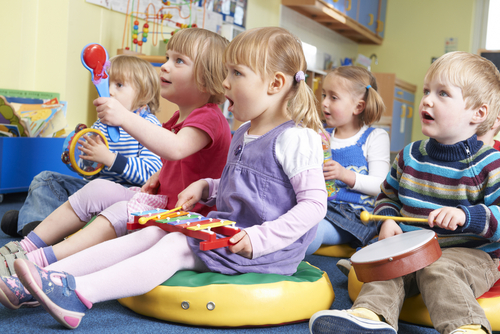Twinkle, Twinkle, I’m a Little Teapot, Jack and Jill — most of us have a favourite nursery rhyme and chances are we have known a few since childhood. For generations, nursery rhymes have been a beloved part of childhood and in early childhood education they can play an important role.
Nursery rhymes and in fact all music has been shown to have a notably positive impact on children’s development, fostering literacy, rhythm, memory, and vocabulary. Incorporating nursery rhymes can also support the nurturing of strong bonds between educators, parents, and children. With World Nursery Rhyme Week coming up from November 13 to 19, 2023, take the opportunity to explore why nursery rhymes have a special place in early childhood education.

The vital role of nursery rhymes for children
In early childhood education and parenting, nursery rhymes can open the door to a world of fun and imaginative learning. They offer a range of benefits that can have a lasting effect on children’s development and wellbeing.
When we use nursery rhymes for children in early childhood education settings, we can expect to gain a number of benefits, including these:
Promote cognitive development and literacy
Nursery rhymes are more than just catchy earworms — they can also be an accessible gateway to literacy. The repetitive nature of rhymes guide children in recognising patterns and sounds, building a strong foundation for reading and writing. As children sing along, they also learn to associate words with their meanings, enhancing their comprehension skills too.
In addition, nursery rhymes can also support international learners with language acquisition, expanding vocabulary and helping it stick.
Enhance memory and sense of rhythm
The rhythmic nature of nursery rhymes makes them easier to remember, which can be captivating for young minds. This melodic element can support children in enhancing their memory and recall ability, paving the way for lifelong learning success.
Boost creativity
Children thrive on fun and nursery rhymes offer plenty of it for play-based learning settings. There’s no shortage of imaginative characters and whimsical tales in nursery rhymes to spark a sense of wonder, enriching a child’s world.

Practical ways to explore nursery rhymes in early childhood
As well as reciting nursery rhymes and singing along together, educators can lean even further in to the many benefits of nursery rhymes.
You might like to try a few of these practical ways to connect with nursery rhymes and maximise their positive impact:
Puppet shows: With puppets to represent characters in different tales, you can bring the magic of nursery rhymes to life for children in early childhood education. You can even support children in making the puppets for additional creativity and engagement. Play School is always a great place to get inspired.
Performance fun: Acting out nursery rhymes can be a fun way of exploring stories and characters. Use props to set the scene, have fun with costumes and encourage children to play the role of their favourite characters.
Explore online resources: Leverage the digital age by exploring websites and apps that can offer a wide selection of nursery rhymes. Engaging animations and interactive features can provide dynamic ways to have fun in the world of nursery rhymes. For example, The Beanies even add a fun Australian twist to a classic with their take on Old MacDonald!
The power of nursery rhymes in early childhood education
Harnessing nursery rhymes in early childhood education can be a powerful tool for children’s development. Be inspired by World Nursery Rhyme Week and make a point of exploring nursery rhymes in your service. These age-old rhymes can have a special place in children’s hearts, while supporting them to grow and learn.
For more information about our courses or the sector, get in touch.



